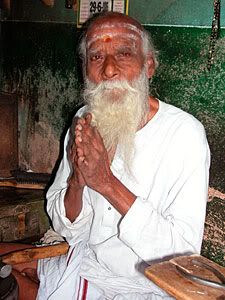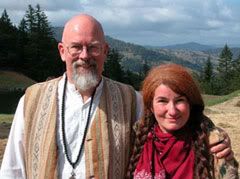Shopping in Bangalore
Today we spent the day exploring the streets of Bangalore, shopping for things that we'll need while living at the ashram. We'll be three hours north of Bangalore, so it's a good idea to stock up on necessities while we're still in the big city.
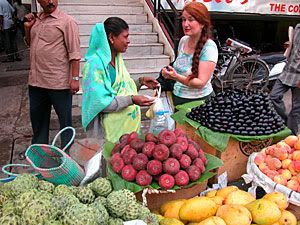 While walking through the streets of Bangalore, you find many vendors selling a broad variety of fruit, including mangos and mellons, as well as nuts, like cashews. If you're a foreigner, it's important to only eat peeled fruit, otherwise your digestive tract may be in for a big surprise.
While walking through the streets of Bangalore, you find many vendors selling a broad variety of fruit, including mangos and mellons, as well as nuts, like cashews. If you're a foreigner, it's important to only eat peeled fruit, otherwise your digestive tract may be in for a big surprise.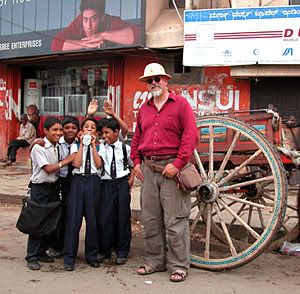 Like any other country in the world, children in India are often curious about foreigners and will quickly gather around you, eager to talk. Sometimes they're too shy to talk but curious all the same. Usually a smile and a few kind words will quickly break the ice.
Like any other country in the world, children in India are often curious about foreigners and will quickly gather around you, eager to talk. Sometimes they're too shy to talk but curious all the same. Usually a smile and a few kind words will quickly break the ice. Indians are big movie fans. The Indian film industry, sometimes known as Bollywood, produces twice as many films per year as Hollywood. Indian movie stars are practically worshipped as gods but Indians are also big fans of American movies and are very familiar with American film stars. If you want a unique cinema experience, go to a popular Indian movie, starring some of their most famous stars, and be prepared for an audience that responds more enthusiastically than any you've ever experienced.
Indians are big movie fans. The Indian film industry, sometimes known as Bollywood, produces twice as many films per year as Hollywood. Indian movie stars are practically worshipped as gods but Indians are also big fans of American movies and are very familiar with American film stars. If you want a unique cinema experience, go to a popular Indian movie, starring some of their most famous stars, and be prepared for an audience that responds more enthusiastically than any you've ever experienced.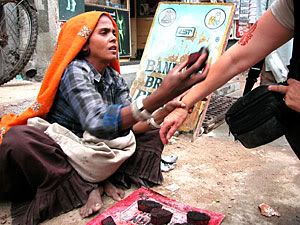 When we encountered the Henna Lady we had no idea what she was selling. We paused for a moment (big mistake) and looked at what she had laid on the ground before her. Suddenly, she grabbed Tara's hand and began stamping henna designs all over Tara's arm faster than you could blink an eye. We learned a good lesson. Never go near the Henna Lady.
When we encountered the Henna Lady we had no idea what she was selling. We paused for a moment (big mistake) and looked at what she had laid on the ground before her. Suddenly, she grabbed Tara's hand and began stamping henna designs all over Tara's arm faster than you could blink an eye. We learned a good lesson. Never go near the Henna Lady.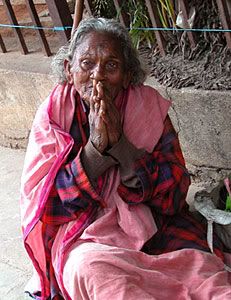 One of the facts of life in India, as in many developing countries, is the presence of beggars, who at times can be very insistent that you give them money. They tend to target foreigners more than local residents because the locals rarely give them money. Often, you'll be faced with extremely pitiful cases that will break your heart to see. It's wise to carry a supply of small coins, like one or two rupees to give them, so that they'll finally leave you alone. If you don't give them anything, they may follow you for blocks. There's also an art to giving to beggars. Don't ever give to them while standing still in one location. Give them a small coin or two while moving and keep moving. Otherwise a crowd may gather making it hard to move on. If you are a sensitive person, dealing with beggars may bring up many emotions that are difficult to deal with but it's a reality of life. Stepping out of the isolated cocoon of your normal daily existence and facing the reality of the intense suffering being experienced every moment by a large portion of humanity, can be a valuable experience that breaks your heart but opens it as well.
One of the facts of life in India, as in many developing countries, is the presence of beggars, who at times can be very insistent that you give them money. They tend to target foreigners more than local residents because the locals rarely give them money. Often, you'll be faced with extremely pitiful cases that will break your heart to see. It's wise to carry a supply of small coins, like one or two rupees to give them, so that they'll finally leave you alone. If you don't give them anything, they may follow you for blocks. There's also an art to giving to beggars. Don't ever give to them while standing still in one location. Give them a small coin or two while moving and keep moving. Otherwise a crowd may gather making it hard to move on. If you are a sensitive person, dealing with beggars may bring up many emotions that are difficult to deal with but it's a reality of life. Stepping out of the isolated cocoon of your normal daily existence and facing the reality of the intense suffering being experienced every moment by a large portion of humanity, can be a valuable experience that breaks your heart but opens it as well.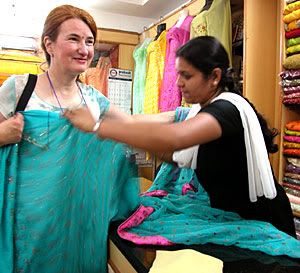 We went to get our "Indian whites," known as kurtas (for men) and punjabis (for women). That's all that is worn at the ashram, other than saris for women on special occasions. Actually, once we wore a kurta and punjabi, we wanted to wear them all the time. They're loose and light and far more comfortable than western clothing. The price is good too. A kurta or a punjabi can be purchased for $10 to $20, and that includes both the pants and the top. While Tara was looking at punjabis, the sales clerk did her best to convince Tara to buy a sari by wrapping saris in a multitude of colors around her.
We went to get our "Indian whites," known as kurtas (for men) and punjabis (for women). That's all that is worn at the ashram, other than saris for women on special occasions. Actually, once we wore a kurta and punjabi, we wanted to wear them all the time. They're loose and light and far more comfortable than western clothing. The price is good too. A kurta or a punjabi can be purchased for $10 to $20, and that includes both the pants and the top. While Tara was looking at punjabis, the sales clerk did her best to convince Tara to buy a sari by wrapping saris in a multitude of colors around her.  Another Indian custom is that women often wear a bindi, also known as kumkum, mangalya, tilak, sindhoor and by other names. The bindi is a small dot placed between the eyebrows on what is often refered to as the "third eye." Traditionally, Indian women placed a red dot made with vermilion (finely powdered bright red mercuric sulphide). Nowadays packages of bindis in various colors and designs with adhesive backing can be purchased for a few rupees (cents). When Tara asked the sales girl about how to wear bindis, she went out and purchased several packs of bindis for Tara.
Another Indian custom is that women often wear a bindi, also known as kumkum, mangalya, tilak, sindhoor and by other names. The bindi is a small dot placed between the eyebrows on what is often refered to as the "third eye." Traditionally, Indian women placed a red dot made with vermilion (finely powdered bright red mercuric sulphide). Nowadays packages of bindis in various colors and designs with adhesive backing can be purchased for a few rupees (cents). When Tara asked the sales girl about how to wear bindis, she went out and purchased several packs of bindis for Tara.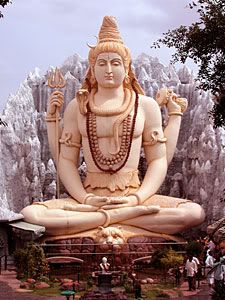 After shopping at Kemp Fort, Bangalore's largest department store, we walked out the back door and were amazed to see the largest Shiva statue in the world. The statue is sixty feet tall and totally magnificent. We considered this a highly auspicious blessing, since tomorrow we leave for our year at Sri Kaleshwar's Soul University, where we will be studying to develop our soul capacity, realize the divinity within, and the unique purpose we are to fulfill in this lifetime.
After shopping at Kemp Fort, Bangalore's largest department store, we walked out the back door and were amazed to see the largest Shiva statue in the world. The statue is sixty feet tall and totally magnificent. We considered this a highly auspicious blessing, since tomorrow we leave for our year at Sri Kaleshwar's Soul University, where we will be studying to develop our soul capacity, realize the divinity within, and the unique purpose we are to fulfill in this lifetime.  Before leaving this magnificent statue of Shiva, Lord of Yogis, we made a wish that we may grow in wisdom and realize the full capacity of our souls so that we may be more effective in alleviating the suffering of humanity.
Before leaving this magnificent statue of Shiva, Lord of Yogis, we made a wish that we may grow in wisdom and realize the full capacity of our souls so that we may be more effective in alleviating the suffering of humanity.
 We left Los Angeles early Monday morning with as much as we could squeeze into two backpacks and two small suitcases each. We traveled light, figuring that we really didn't need much and whatever else we might need we could buy for far less in India.
We left Los Angeles early Monday morning with as much as we could squeeze into two backpacks and two small suitcases each. We traveled light, figuring that we really didn't need much and whatever else we might need we could buy for far less in India.  We noticed on the flight, which was our first inside India, that everyone was very quiet. The flight attendants were extremely refined and actually looked like someone had cast them to play the role of Indian gods and goddesses. Their faces of both the men and women were sublimly beautiful with extremely refined features.
We noticed on the flight, which was our first inside India, that everyone was very quiet. The flight attendants were extremely refined and actually looked like someone had cast them to play the role of Indian gods and goddesses. Their faces of both the men and women were sublimly beautiful with extremely refined features.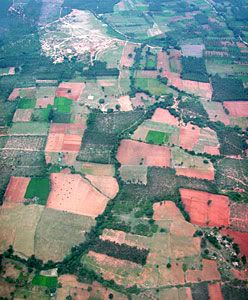 As we approached Bangalore and descended below the clouds, we got our first view of the lush green countryside around Bangalore. Agriculture is the occupation of 80 percent of the population of Karnataka state. Crops abound in rice, millet, cashews, cardamom, betel nut, and grapes as well as coffee and tea.
As we approached Bangalore and descended below the clouds, we got our first view of the lush green countryside around Bangalore. Agriculture is the occupation of 80 percent of the population of Karnataka state. Crops abound in rice, millet, cashews, cardamom, betel nut, and grapes as well as coffee and tea. In the last decade, Bangalore has transformed itself into the "Silicon Valley" of India. From a mere 13 software companies in 1991-92, the number of software companies increased to 938 by August 2001. Some of the reasons for this growth are the pleasant climate, the talent pool of highly trained professionals, and progressive Government policies. Over the last few years, many of the largest high tech companies in America, like Intel and Oracle have been investing billions of dollars in Bangalore.
In the last decade, Bangalore has transformed itself into the "Silicon Valley" of India. From a mere 13 software companies in 1991-92, the number of software companies increased to 938 by August 2001. Some of the reasons for this growth are the pleasant climate, the talent pool of highly trained professionals, and progressive Government policies. Over the last few years, many of the largest high tech companies in America, like Intel and Oracle have been investing billions of dollars in Bangalore. 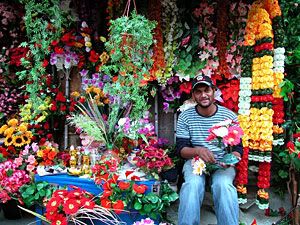 Arriving in India is of course a culture shock. All the sights, sounds, aromas and flavors of Indian life assault and seduce the senses. It's easy to get caught up in the bustle of life - the continual flux of perhaps the oldest culture on earth. It's easy to be distracted by the cacauphony of motor bikes and cars all honking to make their way through the teeming throng of humanity.
Arriving in India is of course a culture shock. All the sights, sounds, aromas and flavors of Indian life assault and seduce the senses. It's easy to get caught up in the bustle of life - the continual flux of perhaps the oldest culture on earth. It's easy to be distracted by the cacauphony of motor bikes and cars all honking to make their way through the teeming throng of humanity. 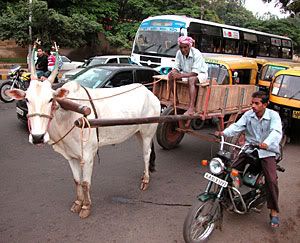 It's a land where bullock carts wait at traffic lights next to young men on motorbikes on their way to jobs at call centers. While China has been considered the next rising superpower, India is believed by many to have a greater chance due to it's being a democracy and largely English speaking.
It's a land where bullock carts wait at traffic lights next to young men on motorbikes on their way to jobs at call centers. While China has been considered the next rising superpower, India is believed by many to have a greater chance due to it's being a democracy and largely English speaking. Another advantage is that India is a culturally diverse and by-and-large extremely tolerant society where Muslims, Hindus, Christians and Jains live together and it is not uncommon to see a temple and a mosque existing side by side.
Another advantage is that India is a culturally diverse and by-and-large extremely tolerant society where Muslims, Hindus, Christians and Jains live together and it is not uncommon to see a temple and a mosque existing side by side.  It's a land of stark contrasts, where ancient motifs remain within the rapid modernization that is sweeping India out of the third world. Everywhere you go, you see images evoking India's spiritual heritage. Shines to Ganesha, the Remover of Obstacles are as common as Starbucks in America.
It's a land of stark contrasts, where ancient motifs remain within the rapid modernization that is sweeping India out of the third world. Everywhere you go, you see images evoking India's spiritual heritage. Shines to Ganesha, the Remover of Obstacles are as common as Starbucks in America. 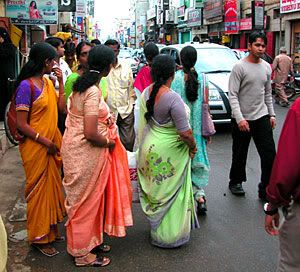 But, we're here for a deeper purpose, to penetrate into the soul of India and imbibe it's rich spiritual heritage. This is what makes India truly unique. The spiritual currents run so deep in India that they permeate the very fabric of life like no other country in the world.
But, we're here for a deeper purpose, to penetrate into the soul of India and imbibe it's rich spiritual heritage. This is what makes India truly unique. The spiritual currents run so deep in India that they permeate the very fabric of life like no other country in the world. 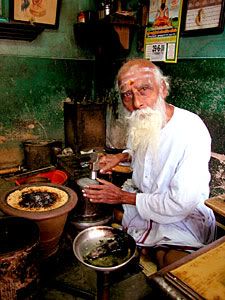 While taking a walk in the side streets of Bangalore today, we spied in the shadows of a small stall, a divine personage working at his craft. His being radiated peace and wisdom shown in his eyes. After asking if we could take his picture, he raised his hands in pranam (blessing) and chanted a prayer to God. We replied, "Hari Om. Om Sai. Sri Sai. Jai Jai Sai. Om Tat Sat. We spoke a universal language and in that moment two Americans and an Indian swami were united in a divine emotion that is both ancient and totally modern for it is beyond time, yet exists throughout time
While taking a walk in the side streets of Bangalore today, we spied in the shadows of a small stall, a divine personage working at his craft. His being radiated peace and wisdom shown in his eyes. After asking if we could take his picture, he raised his hands in pranam (blessing) and chanted a prayer to God. We replied, "Hari Om. Om Sai. Sri Sai. Jai Jai Sai. Om Tat Sat. We spoke a universal language and in that moment two Americans and an Indian swami were united in a divine emotion that is both ancient and totally modern for it is beyond time, yet exists throughout time